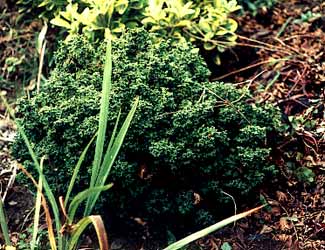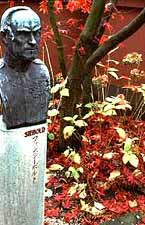 I. 'Plumosa Compressa'
I. 'Plumosa Compressa'
Dwarf Sawara or
Japanese False Cypress
Chamaecyparis pisifera 'Plumosa Compressa' is slow-growing to a roundish three by three feet, occasionally four. When very mature it may spread wider than tall, developing a flat top, but is easily side-trimmed to remain round & compact if that's preferred.
The yellow-tipped bluish grey-green needles give a fluffy or even mossy-looking appearance, excellent in sun rockeries or low-maintance gardens or entryways from the street, though it is only moderately drought hardy & needs regular watering especially its first two or three years.
All C. pisifera cultivars will balk at alkaline or overly compacted soils, so won't replace dwarf junipers in the nastiest roadside conditions, but is the preferred choice in sun-gardens that are at least slightly cared for & tended.
The mossy-looking "plumosa" varieties of Japanese false cypress are a striking contrast to the threadleaf "filifera" varieties. We have two filifera cultivars, Mops, & Sungold; & we have two plumosa varieties, 'Plumosa Compressa,' & the diminuative Creamball. 'Creamball' is a further dwarfed form of 'Plumosa Compressa' & shares with it the trait of palest yellow or cream-colored tips. The pale highlights are particularly noticeable on 'Plumosa Compressa' in spring & summer, contrasting to its bluish grey-green overall color. It does not ordinarily need sheering to keep its roundish formal shape.
It originated as a spontaneous mutation of a slightly earlier cultivar called 'Squarrosa' (also known as 'Blue Dwarf'), & was further developed by Koster & Zonen who introduced it to gardening in 1929 at Van Ness & Zoon Nursery in Holland. It differed from 'Squarrosa' in that it had a fluffier look to the needles. It was immediately popular for beginning bonsai, as well as for use as a sunny rockery item.
II. Philipp Franz Balthasar von Siebold
Introduces Sawara to the West
Curiously enough, all these small cultivars are derived from a species that is a giant upright tree significant to the Japanese lumber industry. Dwarfed, gardened varieties grown on the artificial island of Deshima off Nagasaki were sent to Europe by Philipp Franz Balthasar von Siebold (1796-1866), approximately in 1860.Part of my love of gardening extends to an interest in the lives of daring plant-hunters. I love while gazing at some shrub in the gardens to remember the botanists & explorers who introduced so many Asian ornamentals to western temperate gardening, & C. pisifera provides the perfect opportunity to speak a bit more of von Siebold.
 Doctor von Siebold first went to Japan in 1823, where he took a Japanese wife named Toki (though they were not legally married), by whom he had a daughter, Ine, who lived until 1903. He initially took care of the medical needs of the very small Dutch colony, but was soon teaching medicine to men chiefly of the samurai class.
Doctor von Siebold first went to Japan in 1823, where he took a Japanese wife named Toki (though they were not legally married), by whom he had a daughter, Ine, who lived until 1903. He initially took care of the medical needs of the very small Dutch colony, but was soon teaching medicine to men chiefly of the samurai class.He performed many successful cataract operations on Japanese citizens at a time before Japan was opened to the west. In consequence he had many Japanese friends happy to have their sight restored, in addition to many students grateful for medical knowledge. Many were eager to help him with his botanical, scientific, historical, & cartographical interests. After a few years the government became suspicious of him for smuggling maps, books & art objects out of Japan.
After harrassment of himself & imprisonment of many of his Japanese friends, some few of whom were to die incarcerated, Dr. von Siebold was banished from Japan. In the Netherlands & Germany he continued his studies & wrote several books on Japan, including Manners & Customs of the Japanese (1841), wherein he notes that even the humblest of Japanese people required gardens, even if only a little corner insufficient for more than a little pot of dwarfed evergreens.
 After repeated attempts to get the ban lifted so that he could return to Japan which he loved, he was finally permitted back in 1859, as a diplomat in service of the Dutch. He affirmed old friendships & made new ones & undertook a major campaign to bring plant specimens to Europe.
After repeated attempts to get the ban lifted so that he could return to Japan which he loved, he was finally permitted back in 1859, as a diplomat in service of the Dutch. He affirmed old friendships & made new ones & undertook a major campaign to bring plant specimens to Europe.His tendency to favor Japanese political interests over the Dutch meant his mission was judged a failure & he was forced into retirement in 1861. He died a few years later in Munich, having devoted the greater portion of his adult life to the study of Japanese culture & natural history. His son Heinrich later lived in Tokyo, & continued some of his father's work, but with his personal interest being in prehistoric Japan.
 Today he is commemorated at the German city of Wurzburg (where he was born) with a museum in his honor. He has long been reclaimed even by the Japanese, & a postage stamp was issued in Japan in 1996 to honor the 200th anniversary of his birth. A bust of him (shown on the left) stands in a Japanese Garden at Leiden University, the plants being descended from the 2000-odd species he himself brought to the Netherlands.
Today he is commemorated at the German city of Wurzburg (where he was born) with a museum in his honor. He has long been reclaimed even by the Japanese, & a postage stamp was issued in Japan in 1996 to honor the 200th anniversary of his birth. A bust of him (shown on the left) stands in a Japanese Garden at Leiden University, the plants being descended from the 2000-odd species he himself brought to the Netherlands.Some of the plants he sent to the Netherlands from the Dutch colony were from the gardens of his Japanese friends or from the little Deshima Botanical Garden. Many other plants from Chinese & Korean gardens were from seeds smuggled to him from the mainland.
Before the end of his second Japanese sojourn he was joined by a physician from America, George Rogers Hall, who sent many of the same plants to New England, including ten gardened varieties of the Sawara False Cypress. This species proved to be unusually susceptible to mutation & there are today hundreds of dwarf cultivars descended from those first specimens sent to Holland & New England.
III. Four Years Later:
A Hard Decision
After four years in the ground, I never quite built up as much of a liking for 'Plumosa Compressa' as I had for all the other varieties of Sawara in our gardens.It wasn't the shrub's fault. It was strictly a matter of taste; it had looked better in the nursery than it did in my garden. Perhaps I planted it in the wrong place for best presentation of its finer traits. Whatever the reason, it always looked wrong & I thought of it as a mistaken purchase. I kept hoping it would begin to appeal to me more as it matured, or that as I hemmed it in with other plants, it wouldn't be so much the center of its spot & it wouldn't matter that it wasn't a favorite.
I find myself superstitiously wondering if thinking less than positive thoughts about a plant doesn't doom it. During the summer of 2003, it got heat-stressed during record hot weeks. Undoubtedly my tepid feelings about it permitted me to overlook its watering requirements during a major drought, or its location at the top of a sloping garden meant it drained a little too well & dried out more wholeheartedly than occurred along the rest of the incline. It never showed outward signs of suffering, but suddenly it was unexpectedly attacked by spider mites.
I treated this by organic methods including cold water sprays & horticultural neem oil, plus there were still a lot of lady beetles from releases earlier in the year, & I cleared away all rubble or leaf matter around the shrub to isolate it. With the moderate approach avoiding chemicals, & with a better watering schedule for the health of the shrub, the mites soon vanished, to my great relief, never getting on anything else. But the insides of the compact shrub had been savaged.
The shrub didn't look too awfully bad because the mites for some reason preferred to do their dirty work at the center of the shrub. So it was like a "rind" of green hiding a browned dead-looking interior.
I'd off & on in previous years thought of getting rid of this shrub even before it had this health problem. Yet I waited a couple more months to see how the shrub recovered from the mites. But I grew impatient & made a really stupid attempt to sheer it back a bit, which had the effect of revealing more of the dead interior. A month after that dumb move, I dug it up to discard.
Very likely I should just have dug it out long before, when it first became clear to me I didn't like it as much as I'd expected to. Many a gardener knows that with any plant one obtains, if it in any way fails one's expectations, what the heck, get rid of it. Compost it & replace it with something better liked. Or give it away if someone who likes it better. Or exile it to the least important corner of the property. One great thing about a garden is it is never static, it changes constantly & naturally, & can have further change imposed on it at any time. A gardener is never really "stuck" with a first choice if she doesn't want to be.
But others, & I fear I'm too often in this category, feel a high degree of responsibility for every plant's life. Such heightened sentiment should be reserved more for sentient beings such as kids or pets. One doesn't discard a child for being less attractive than some other kid, or have a pet put down because it peed on the floor. In my case, a similar sense of commitment causes me to treat plants as responsibilities I've taken on as lifetime duties.
A sense of responsibility is a good thing, as without it one might fail to care adequately for the entire garden. But if one ends up tolerating a shrub that has not fulfilled its original intent, the gardener may by subtle & subconcious means undermine the vitality of that plant anyway, just like when I underwatered the 'Plumosa' during a heat wave, compromising its health. And for the four years this purchase was tolerated despite all second thoughts about it, there could've been something much more greatly loved maturing in that spot.